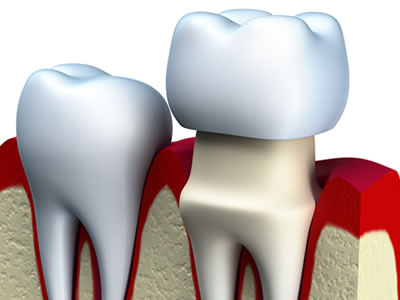Dental crowns are both a cosmetic and restorative tool used in dentistry. They can be used to cover unsightly chips and cracks, and are also useful for maintaining the structural integrity of a damaged tooth.


What Is A Dental Crown?
A simple way to think of a dental crown is as a small cap or helmet that goes over a damaged tooth. It both restores the shape and look of the tooth, while preventing the chips and cracks from getting worse.
Dental crowns are typically either made of porcelain or a composite material. Sometimes metal alloys are used.
While many people may think gold dental work is for people who want to show off, it’s actually an excellent material for dental restorations. Dental crowns made of gold are more durable and longer lasting than any other option.
Dental crowns are also used to restore a tooth as part of a dental implant. The crown sits on top of the implant as the final stage of the process.
What’s The Process For Dental Crowns?
The first step will generally be to shave down some of the enamel from the tooth. This is necessary to make room for the restoration.
Next, an impression is made of your teeth. This can either be done with traditional mould-making materials, or as is more and more popular today, with digital scanning technology.
These impressions are used to design the crown. It’s important that the crown fits well in the mouth. If it doesn’t, it can actually end up breaking the tooth it’s meant to protect.
Manufacturing the crown can take one of two forms. The traditional method is to make the crown in a lab with a skilled technician. This can take a few days and necessitates two trips to the dentist — one for prep, and another to have the restoration set in place.
The other option is to use a milling machine such as the CEREC machine. These use digital mouth scans and digitally tooth designs to precisely shape the restoration in a special machine. These crowns are then ready to be placed on the same day as your initial visit.
Some dentists use same-day crowns for all of their restorations, others use them as temporary restorations while the final version is made in the lab.
Either way, once the crown has been manufactured it’s cemented onto the tooth.
Are There Alternatives to Crowns?
Inlays and onlays are similar to crowns. Instead of fixing the whole crown of the tooth, they fix a select part of it. Inlays fix the dips in teeth, known as the cusps. Onlays fix the pointed parts of teeth.
The process for inlays and onlays is the same as for a full crown. Benefits include less time to make the restoration and generally lower cost.